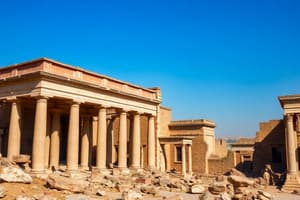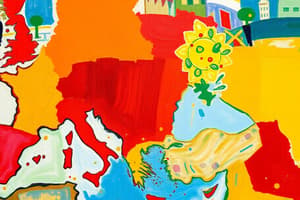Podcast
Questions and Answers
What contributed to the rise of cities in the Roman Empire?
What contributed to the rise of cities in the Roman Empire?
- Decline in economy
- Hellenism (correct)
- System of roads and shipping (correct)
- Expansion of slave trade
The Roman Empire was able to manage its vastness effectively.
The Roman Empire was able to manage its vastness effectively.
False (B)
What was a significant event during the East-West split of the Roman Empire?
What was a significant event during the East-West split of the Roman Empire?
The Empire was divided by Theodosius' sons.
Who was the king of the Huns that threatened Rome?
Who was the king of the Huns that threatened Rome?
What economic change occurred after the fall of the Western Roman Empire?
What economic change occurred after the fall of the Western Roman Empire?
The Dark Ages were truly dark with no significant developments.
The Dark Ages were truly dark with no significant developments.
What replaced the Roman Empire as the most powerful force in Europe during the Dark Ages?
What replaced the Roman Empire as the most powerful force in Europe during the Dark Ages?
What were the materials more commonly used for construction after the fall of the Western Roman Empire?
What were the materials more commonly used for construction after the fall of the Western Roman Empire?
Flashcards are hidden until you start studying
Study Notes
Roman Empire Decline
- The Roman Empire became too vast and difficult to manage.
- The economy was bankrupt.
- Slave trade was low due to lack of expansion.
Key Dates and Events
- 379-395: The Eastern and Western Roman Empires split after the death of Theodosius.
- 401-410: Visigoths sack Rome under the rule of Alaric.
- 429- 435: Vandals, led by Gaiseric, sack North Africa, disrupting Roman grain supply.
- 440-454: Huns led by Attila attack Rome, threatening the empire.
- 455: Vandals sack Rome for the fourth time.
- 476: The last Western Roman emperor, Romulus Augustulus, is deposed by Odoacer, marking the fall of the Western Roman Empire.
- Odoacer declares himself king of Italy.
Aftermath Of The Roman Empire
- Rome was left in ruins after the fall of the Western Empire.
- The economy declined significantly.
- There was no central government to oversee construction projects.
- Wood and straw became primary building materials due to availability and cost effectiveness.
The Transition Period
- The period following the fall of the Western Roman Empire is known as the Dark Ages.
- It was a time of transition into the early Middle Ages.
- The decline of Roman power led to the emergence of independent territories within the former empire.
- The lack of centralized government halted major construction projects.
- Wars between former territories shifted focus from building towards territorial defense and conquest.
The Rise of The Church
- The Church became the most powerful force in Europe, filling the void left by the Roman Empire.
- It redefined the relationship between church and state.
- Agriculture thrived during the Early Middle Ages.
Romanesque Architecture
- Romanesque architecture emerged following the Dark Ages.
Studying That Suits You
Use AI to generate personalized quizzes and flashcards to suit your learning preferences.




